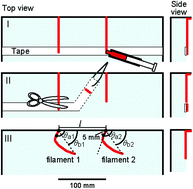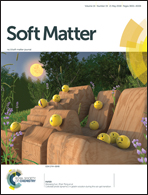Synchronization of self-propelled soft pendulums†
Abstract
We investigated self-propelled motions of thin filaments atop water, where we focused on understanding pendulum-type oscillations and synchronization. The filaments were produced from a commercial adhesive (consisting mainly of nitrocellulose and acetone), and exhibited deformable motions. One end of each filament was held on the edge of a quadrangular water chamber while the other was left free. Acetone and other organic molecules from the nitrocellulose filament develop on the water surface and decrease the surface tension. The difference in the surface tension around the filament becomes the driving force of the self-propelled motions. When a single filament was placed in the water chamber, a pendulum-type oscillation in the deformation of the filament was observed. When two filaments were placed in parallel in the chamber, in-phase, out-of-phase, and no-synchronization motions were observed. It was found that the class of motions depends on the distance between the two fixed points of the filaments. Mathematical modeling and numerical simulations were also used in order to further understand the dynamics of the surface active molecules and the filament motions. We propose a mathematical model equation and reproduce various behaviors exhibited by soft self-propelled matters through numerical simulation.



 Please wait while we load your content...
Please wait while we load your content...